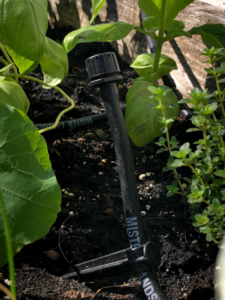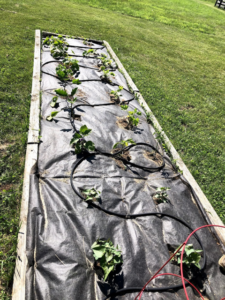Q: I am planning to install a raised bed vegetable garden irrigation system. What are some things I should be considering?
By Kathryn Schick, Piedmont Master Gardener Intern
Irrigation systems can be a game-changer for home gardeners looking to maximize efficiency and conserve water. Traditional watering methods (hand watering, spray-irrigation, flooding) typically saturate the ground by direct application above the soil. While these methods provide broad coverage, they are often less precise, waste water and distribute moisture unevenly. By contrast, there are irrigation systems that can deliver water directly to the roots of plants. These systems can also reduce evaporation and ensure that plants receive the precise amount of water needed to thrive. Whether growing vegetables, herbs, or flowers, installing an irrigation system in your home garden can improve plant health, save water, and minimize the time spent watering.
While irrigation systems can benefit all types of gardens, it is particularly useful to install them in raised beds, which dry out more quickly than ground-level gardens. In areas prone to droughts, there is even more reason to consider some form of irrigation. Virginia is one of these States – it is currently experiencing either abnormally dry, or moderate or severe drought conditions and has had multiyear droughts in 1999-2002, 2007-2008 and 2010-2012.

Choosing An Irrigation System
Not all irrigation systems are alike. Of the three main types of irrigation systems, two are appropriate for home gardeners.
- Drip Irrigation, also called micro-irrigation, is a system of plastic pipes and flexible tubing with fittings that deliver water directly to plant roots. Water is applied slowly and at low pressure, so roots can absorb adequate amounts of water uniformly and consistently. It also reduces weed growth because areas between plant rows are not watered. Because leaves and flowers stay dry, plants are more resistant to disease. Runoff, overspray, excessive evaporation and overwatering can be minimized. Drip irrigation can easily be customized to the size and shape of the raised bed or in-ground garden. It can also be adapted for container pots by running a single drip line to individual pots from a central feeder line. A variety of attachments (mini-sprinkler heads, soaker lines or slow or fast rate drippers) can be used to customize the system. Initial set up cost will vary depending on the size, configuration, and equipment. These systems are generally fairly easy to assemble, expand, monitor and maintain. Systems can be installed by professional landscapers if the home gardener prefers.
- Soaker Hoses are perforated to slowly release water along their length, evenly watering the soil. They are easy to install, move around and are budget-friendly. They also require minimal equipment. Periodic maintenance is necessary to unclog the hose line. Because soaker hoses degrade over time, they need to be replaced periodically. The hoses should be covered with mulch to protect them from exposure to sunlight and extend their useful life. Soaker hoses can distribute water unevenly due to loss of pressure as the water travels the hose length. Overwatering can result at the spigot end and underwatering at the other end. These hoses are a good option for landscaping, flower beds, and large gardens as long as the garden bed is level and the hose is no longer than 100 feet.
- Sprinkler Systems apply water under pressure from nozzles above plants. The overhead watering increases the risk of disease and causes more water waste than other irrigation systems through evaporation and runoff. They are best suited to areas with less precise watering needs, like lawns, parks, golf courses or farm fields.

The bottom line is that drip irrigation is about 90% more efficient in water consumption than traditional methods like sprinklers, which are between 60 to 75% efficient. Soaker hoses can be highly efficient, depending on how they are installed and maintained.
Planning For Your Irrigation System
Watering Schedule. Consider installing a timer to automate watering. Set it for early morning when the evaporation rate is lower, two to three days a week, so that plants get a total of 1 to 1.5 inches (irrigation plus rainfall) per week. If the water supply is provided by a well, set your garden water schedule for off-peak household water usage times, to avoid potentially draining your well or damaging your well pump.
Adjust the timer based on the weather. Increase watering in the hot summer months and reduce it when it rains, so that the garden gets the standard 1 to 1.5 inches per week. Note that these types of spigot-mounted timers are not four-season rated and require batteries. Remove the timer during winter months to avoid damage to your spigot. Don’t forget to change your batteries at the beginning of every season to prevent failure during peak season.
Water Pressure. Ensure that your irrigation system works well with the lower water pressure used in irrigation systems. Drip systems, for example, often require pressure regulators to adjust the higher water pressure coming from homes to prevent hoses from bursting. Soaker hoses and sprinklers may need pressure regulators to prevent water from being unevenly distributed. These types of regulators are sold next to drip kits at most home improvement stores and can be attached directly to your spigot-mounted water timer. Once all the pieces are attached, make sure to test the system to verify the spigot is set to the appropriate pressure setting. Depending on your home’s water pressure, your spigot might need to remain only half open.
Plant Requirements. Different plants have different water needs. If using a drip system, you will have the flexibility to use adjustable emitters to ensure that groups of plants with the same water requirements get the right amount of water. If using soaker hoses, arrange each soaker hose near plants with the same water needs and place close to the roots for maximum absorption.
System Flexibility. As your garden evolves, you may want to add or move beds. Choose a modular system that allows you to extend or rearrange irrigation lines easily. A quick release hose attachment and a one or two-way restricted flow water shut-off can make moving nozzles and lines easy.
Mulching. Add mulch or compost around your plants to retain moisture and reduce evaporation and the amount of watering needed. Maintaining a consistent water schedule becomes much easier when using mulch in combination with a drip or soaker hose irrigation system.
Tips on Drip System Installation
- Create a to-scale sketch: Know the layout, garden bed size, plant locations and water needs. Measure how much hose and line are needed for the entire garden. Your drawing should account for all fittings, drippers, attachments, and connectors for swift and easy assembly.
- Source the materials. Find a source for the required equipment that you can also rely on for replacement parts in the future.
- Lay the mainline tubing: Lay the tubing along the mainline of the garden bed and attach it to a water source.
- Attach emitters or inline tubing: Lay pre-constructed inline tubing and insert individual drip emitters close to plant roots using stakes provided with drip kit.
- Install a pressure regulator and filter: Most home water systems have higher pressure (50-60 PSI) than drip systems need. (PSI of 25-30 is ideal for drip irrigation.) A filter prevents debris from clogging the emitters.
- Connect to water source: Attach a backflow preventer to stop contaminants from entering your home water system.
- Add a timer (Optional, but highly recommended): Connect the timer at the faucet end for automatic watering. Set according to season, plant hardiness zone, and plant water needs.
- Test the system: Run the system to check for leaks and ensure even water distribution.
For a more details on installation, refer to the Piedmont Master Gardeners’ online newsletter, The Garden Shed, on Drip Irrigation for Home Gardens.
Tips on Soaker Hose Installation
- Lay out the hoses: Place them on the soil surface, weaving them between the plants close to the roots. Secure hoses to the soil with large hose pins.
- Connect to a water source: Use a simple hose connection or a splitter, if running multiple lines. If using a timer, connect the soaker to the timer and then the spigot.
- Check for leaks: Ensure even water distribution along the hose length.
- Bury under mulch: Cover the hoses with mulch to protect them from sunlight and help retain moisture.
Maintenance Tips for Drip Irrigation and Soaker Hoses
- Check for clogs: Drip emitters and soaker hoses can become clogged with dirt or mineral deposits over time. Regularly inspect them and clean, as needed.
- Flush the system: Every few months, open the end caps to flush out any buildup in the tubing.
- Replace parts: Over time, tubing, connectors, and emitters may degrade from exposure to sun or hard water. Inspect the system regularly and replace parts, as needed.
Additional Considerations:
- Water source availability: Ensure that your water source is close enough to the garden for easy connection. Rain barrels can also work as a source of water.
- Flexibility for expansion: Plan for future garden expansion by leaving room in your system for additional lines or emitters.
- Automation: Adding a moisture sensor or smart controller that waters based on soil moisture can further optimize water usage.
The resources below provide additional instructions and diagrams demonstrating exactly how to set up drip irrigation or soaker hose systems.
Featured Image Source: Pexels.com
References
“Building and Operating a Home Garden Irrigation System”, Bogash, Steve, Retired Horticulture Educator, Penn State University, Penn State Extension, 6 May 2014.
“Conserving Water in the Vegetable Garden”, University of Georgia, University of Georgia Extension, Circular 964, 7 Jul 2022.
“Drip Irrigation”, University of Rhode Island, 2024.
“Drip Irrigation for Home Gardeners”, Aminpour, Khosro, The Garden Shed, Vol. 10, No. 4, Piedmont Master Gardeners, Apr 2024.
“Drip Irrigation for Home Gardeners – 4.702”, Wilson, C. & Bauer, M., Colorado State University, Colorado State University Extension, July 2004.
“Irrigation Systems for the Garden”, Bernitz, Nate, University of New Hampshire, University of New Hampshire Extension, 21 Aug 2020.
“Irrigation System Pros and Cons”, University of Missouri, University of Missouri Extension.
“Operating and Maintaining a Home Irrigation System”, Wilson, C.R. et. al, Colorado State University, Colorado State Extension, Fact Sheet 7.239, May 2020.
“Soaker Hoses, Good for Your Garden, Your Wallet and Our Environment”, Saving Water Partnership, Seattle and Participating Area Water Utilities, 2005.